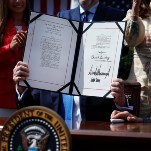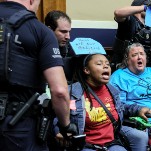The Life Of A Baby Model? Not That Glam
LatestLast week, I was taken aback to hear a friend, recently unemployed, tell me sheepishly that she was thinking of making her son a baby model. “All the parents say he’s the cutest one on the playground,” she said defensively.
Apparently, this isn’t uncommon. As the recession deepens, child modeling agencies are reporting that applications have more than doubled. Perhaps parents’ increased availability as chauffeurs and minders helps, too – although the Times of London reports that some families are so cash-strapped that they’re only able to take modeling jobs that don’t require travel costs. Of course, like all forms of modeling, it’s a world rife with scams and “registration fees” for the naive. Websites like Childmodel.blogspot instruct the parent who would capitalize on a baby’s angelic looks and (more importantly) angelic disposition. Says Baby Modeling Secrets,
-

-

-

-

-

-

-

-

-

-

-

-

-

-

-

-

-

-

-

-

-

-

-

-

-

-

-

-

-

-

-

-

-

-

-

-

-

-

-

-








































